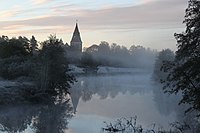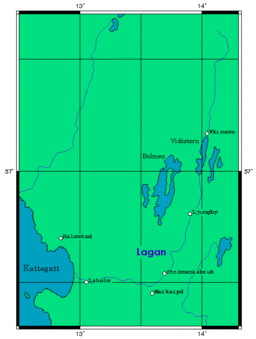Lagan River (Sweden)
| Lagan | |
| River | |
|
Lagan and Hamneda Church in October 2010
|
|
| Country | Sweden |
|---|---|
| Source | Tahesjön |
| - location | Jönköping Municipality, Sweden |
| Mouth | Laholmsbukten, Kattegat |
| - elevation | 0 m (0 ft) |
| - coordinates | 56°32′55″N 12°56′50″E / 56.54861°N 12.94722°ECoordinates: 56°32′55″N 12°56′50″E / 56.54861°N 12.94722°E |
| Length | 244 km (152 mi) |
| Basin | 6,451.8 km2 (2,491 sq mi) |
| Discharge | |
| - average | 82 m3/s (2,896 cu ft/s) |
Lagan is one of four main westcoast rivers in south-western Sweden besides Göta älv. It is with 244 kilometers one of the longest rivers in southern Sweden.
It starts in Tahesjön outside Taberg in the municipality of Jönköping, flows through Vaggeryd, Värnamo and Ljungby and ends in the town of Mellbystrand in the municipality of Laholm. More specifically, it ends in the Bay of Laholm, a part of the strait of Kattegat.
People have been following the river from the coastal areas since the Viking Age and settling in its vicinity. Along Lagan was a trading route, the so-called Lagastigen, which is now part of the road E4.
The straight middle and upper course of Lagan follows a branch of the Protogine Zone —a zone of crustal weakness in western Sweden.
...
Wikipedia


